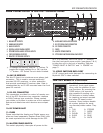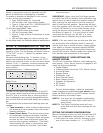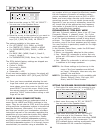
6: MENU CONTROL BUTTONS
SEL
These three buttons labeled “”, “”,
and “SEL” (SELECT) are used to con-
trol the menu and setup functions dis-
played on the LCD. To enter a menu
mode, you can press any one of these
buttons. This will bring up the main
menu. Navigating any menu or sub-
menu is done using the two arrow ( and ) but-
tons. Once the desired submenu or function is
highlighted, pressing “SELECT” will make it the
current menu or function.
To exit a menu, or back up a step use the arrow
buttons to highlight the ‘X’ displayed in the lower
right hand corner of the LCD window and press
“SELECT”, or wait 3 to 4 seconds for the menu to
time out and return to its previous state.
7: SOURCE SELECT BUTTONS & INDICATORS
TV/SAT
TAPEDVD
CD AUX
VCR
Pressing any one of these
buttons will instantly switch
the SP2’s analog and digital
inputs to read the indicated
source.
If the SP2 is in its digital
mode, as soon as any input
is selected and switched, the decoder will auto-
matically try to determine the new bitstream’s type
and mode.
8:
DIGITAL MODE SELECT BUTTON & INDICATOR
MODE
This button operates as a three-way toggle
function. The LED immediately above the
button has two colors - RED and GREEN,
and an OFF mode where it is not illuminat-
ed.
When Digital Mode is selected, the decoder
will automatically default to a digital signal for the
selected input if one is present.
If a digital signal is present and detected, the
SP2 will automatically determine the type of bit-
stream and select the proper decoding mode. The
indicator LED will turn green when this happens.
If NO DIGITAL SIGNAL is detected the SP2 will
default back to the analog input for the selected
source. This also automatically puts the SP2 into
its Digital Standby Mode. When this occurs the LED
indicator will turn RED
In this mode, the decoder will continually check
the selected source inputs for the presence of a
digital signal. If one is detected, the SP2 will auto-
matically switch over to the pre-selected digital
operation mode for that source.
To defeat this auto-digital detect mode you
must press the button again. If you do the LED will
go OFF.
When this mode of operation is selected the
SP2 will look at ONLY its analog inputs. If a digital
signal does appear the SP2 will NOT recognize it
and will remain in its analog only mode until you
press the Digital button again to either select the
digital source or place the SP2 into its auto detect
mode as explained above.
9: SURROUND MODE BUTTON & INDICATOR
SURROUND
Pressing this button will engage the SP2’s
surround listening mode. When this function
is operational the LED will turn green. For
Dolby Digital and DTS bitstreams, the signal
will be decoded and presented with no addi-
tional post-processing. For 2-channel source
material, the SP2 will synthesize surround
information based on the chosen Surround Mode
(see Appendix A: SP2 Surround Modes for more
information).
10: STEREO & STEREO DOwNMIX MODE
STEREO
If this button is selected and the supplied
bitstream is more than 2 channels, the
decoder will automatically implement a ste-
reo downmix. Otherwise, analog or digital
two channel signals are passed as conven-
tional stereo.
11: MONO & MONO DOwNMIX MODE
MONO
If this button is selected and the supplied
bitstream is more than 1 channel, the SP2
software will create a Mono mix of all sig-
nals. If the centre channel is present, the
Mono signal will appear in the centre chan-
nel. If no centre channel is present, the
mono signal will appear simultaneously on the
Left/Right speakers.
NOTE: Downmix [stereo or mono] is a software
based automatic mixing function available within
the SP2. This process exists because whenever the
number of active decoder outputs or loudspeakers
selected in setup is less than the number of chan-
nels in the Dolby Digital program, some channel
combining will be necessary to present the pro-
gram on the available number of channels/loud-
speakers.
As a part of any program’s production, its produc-
ers can set and adjust the type and ratios allowed
for downmixing somewhat to ensure optimum
results without compromising the full Multichannel
balance. This is accomplished by including specific
data within the Dolby Digital bitstream which rep-
5


















